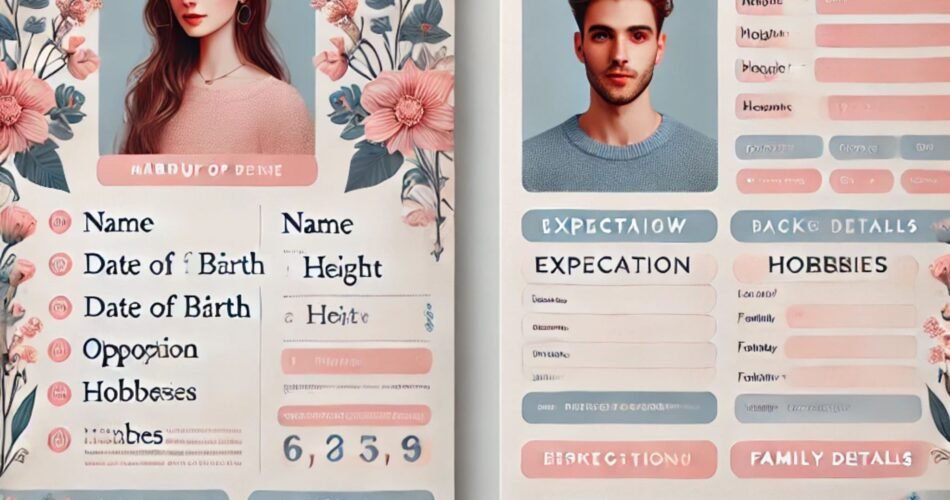In India, the process of marriage is not just about two individuals—it’s about the coming together of families, values, and traditions. One essential part of this cultural journey is the marriage biodata, a document that represents a person’s profile for matrimonial purposes. Whether you’re creating it for arranged marriage proposals or uploading it on matrimonial sites, a well-crafted biodata can make a strong first impression.
This comprehensive guide walks you through everything you need to know to create a compelling, clear, and culturally appropriate marriage biodata in 2025.
What is a Marriage Biodata?
A marriage biodata is a structured summary of an individual’s personal, professional, and family background created for the purpose of finding a suitable life partner. Think of it as a resume, but for marriage—it reflects not just your achievements but your personality, beliefs, and life goals.
This document is typically shared with potential matches or their families to assess compatibility before moving to deeper conversations or formal introductions.
Why is a Marriage Biodata Important?
In arranged marriage setups or even modern matchmaking, first impressions often happen on paper. A clean, well-organized biodata helps families understand the basics about you at a glance. From your profession and education to values and family details, your biodata offers a snapshot of who you are—making it easier for suitable matches to consider moving forward.
Key Sections of a Marriage Biodata
Let’s break down the essential components of a successful marriage biodata:
1. Basic Information
Start with the fundamentals:
-
Full Name
-
Date of Birth & Age
-
Height and Weight
-
Religion & Caste (if applicable)
-
Mother Tongue
-
Nationality
-
Contact Details
Be clear and accurate. Including a recent, decent photograph is highly recommended.
2. Educational Qualifications
This section lists your academic achievements in reverse chronological order:
-
Degree
-
Institution
-
Year of Graduation
Example:
M.Tech in Computer Science, IIT Delhi, 2022
3. Professional Details
Share information about your career path:
-
Current Job Title
-
Company Name
-
Years of Experience
-
Work Location
-
Annual Income (optional)
This helps the prospective family understand your stability and aspirations.
4. Family Background
Family values and background hold immense importance in Indian marriages. Include:
-
Father’s Name & Occupation
-
Mother’s Name & Occupation
-
Siblings (with their education/profession)
-
Family Type (nuclear/joint)
-
Location
This portion contributes to the overall picture of your lifestyle and upbringing.
5. Lifestyle & Personal Interests
Give a glimpse of your personality by listing hobbies, interests, and lifestyle preferences. This may include:
-
Travel
-
Reading
-
Music/Dance
-
Fitness/Yoga
-
Food Habits (Vegetarian/Non-Vegetarian)
Keep it short yet expressive to attract like-minded individuals.
6. Partner Preferences
Outline what you’re looking for in a potential spouse:
-
Age Range
-
Height Range
-
Education
-
Profession
-
Family Values
-
Location Preference
This sets the stage for clear expectations and compatible connections.
Formatting Tips for a Clean Presentation
Design plays a big role in how your biodata is received. Here are a few suggestions to make it stand out:
-
Use bullet points for clarity and easy scanning
-
Maintain a formal tone while being approachable
-
Keep font sizes legible (11–12pt for body, 14–16pt for headers)
-
Avoid overuse of colors or graphics unless requested
-
Include your photo in the top-right or top-center
For those creating a bio data for marriage simple and easy to print, keeping it within one page is best.
Digital Biodata vs Printed Format
Thanks to digital platforms and matrimonial apps, many people now prefer to create and share their marriage bio data online. Digital formats offer convenience, the ability to edit easily, and quick sharing across WhatsApp, email, and matrimonial portals.
Here’s how digital biodata stands out:
-
Editable templates in Word or PDF
-
Mobile-friendly formats
-
Easier to attach on matchmaking sites
-
Can include hyperlinks (LinkedIn, Instagram, etc.)
Still, a well-printed copy might be preferred during in-person meetings with family elders.
Cultural Sensitivity and Clarity
While building your biodata, it’s important to:
-
Avoid exaggeration – Be honest about your achievements and status
-
Respect traditions – Use language and tone appropriate to your family’s values
-
Stay neutral – Avoid political or religious opinions
-
Be inclusive – Especially in sections involving family or caste
A shadi biodata should reflect not just your achievements but also your upbringing, values, and cultural background.
How to Choose a Template
There are several shadi biodata format templates available online that you can customize according to your needs:
-
Traditional Format: Includes caste, gotra, horoscope details
-
Modern Format: Focuses on education, career, and lifestyle
-
Minimalist Format: Ideal for those who prefer simplicity
-
Religious Format: Includes spiritual beliefs, practices, etc.
Choose a style that resonates with your background while maintaining clarity and structure.
Sample Layout: Simple Biodata for Marriage
Here’s a basic outline of what a simple biodata for marriage might look like:
[Your Photo]
Name: Rahul Sharma
Date of Birth: 15 March 1995
Height: 5’11” | Weight: 72 kg
Religion/Caste: Hindu, Brahmin
Education: MBA, IIM Ahmedabad
Profession: Senior Manager at Infosys, Bangalore
Annual Income: ₹20 LPA
Family:
-
Father: Retired Banker
-
Mother: Homemaker
-
One younger sister (BDS)
Hobbies: Reading, Cricket, Traveling
Partner Preference: Educated, working professional, 24–28 years
This example demonstrates how to present information concisely and neatly.
Final Thoughts
Creating a compelling marriage biodata doesn’t have to be overwhelming. It’s about presenting yourself genuinely while respecting cultural norms. Whether you choose a traditional design or opt to build your marriage bio data online, remember the goal is to make it easier for the right match to find you.
Pay attention to layout, keep your tone warm yet professional, and double-check for accuracy. And above all, be honest—because the best biodata is the one that reflects the real you.
